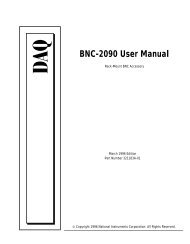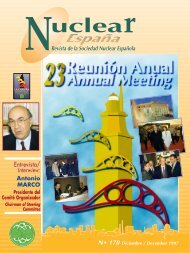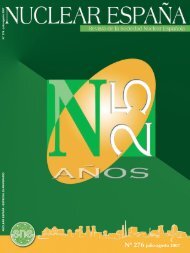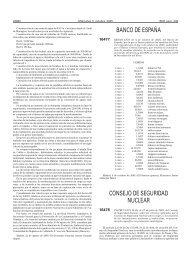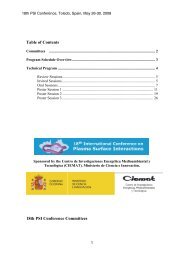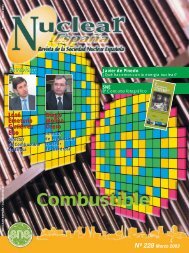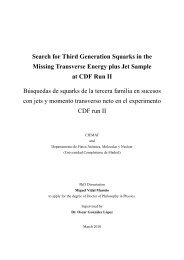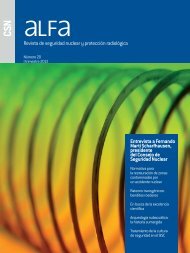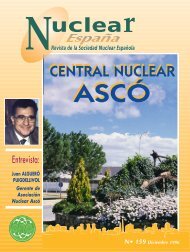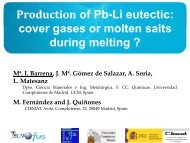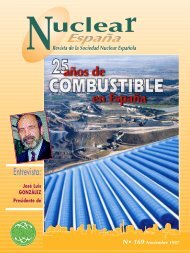EntrEntr evista/evista/ InterInter viewview
EntrEntr evista/evista/ InterInter viewview
EntrEntr evista/evista/ InterInter viewview
Create successful ePaper yourself
Turn your PDF publications into a flip-book with our unique Google optimized e-Paper software.
The results obtained in the last inspection and<br />
measurement of the oxide layer of Siemens<br />
FOCUS type fuel are very satisfactory, as the<br />
measured oxide layer maintains approximate<br />
values of 50% of the limit, with burn degrees of<br />
some 50,000 MWd/Tn. In addition, we are<br />
completing a first cycle with 4 ENUSAmanufactured<br />
assemblies, which also have not<br />
shown any anomalies.<br />
F IV<br />
1800<br />
1600<br />
1400<br />
1200<br />
EXPOSICIÓN COLECTIVA / COLLECTIVE EXPOSURE<br />
1696,9<br />
Most Significant Incidents<br />
The plant operated throughout the year without<br />
any significant safety-related incidents.<br />
• Reportable events.<br />
Twelve CSN-reportable events occurred and 3<br />
special reports were made during the year, all of<br />
them of little relevance. The causes were as<br />
follows:<br />
Human error ............................. 2 events<br />
Equipment failure ....................11 events (4 of<br />
them due to turbine vibrations)<br />
Modification/preventive m. ..... 2 events<br />
As regards operating state, the global analysis<br />
indicates that the events occurred:<br />
With the plant in operation ..... 10 reportable<br />
events<br />
With the plant in shutdown or<br />
startup ..................................... 2 reportable<br />
events and the 3 special reports<br />
• Incidents impacting production.<br />
Figure 7 shows the incidents that occurred during<br />
1999 that impacted production, except for the<br />
turbine valve tests. In addition to the load reductions<br />
resulting from the turbine valve tests, production was<br />
affected on the following occasions:<br />
- January: on discovering that several penetrations<br />
of building ZB were provisionally sealed when<br />
cables were being laid for alternating current<br />
modification, a test was performed that confirmed<br />
that the building’s watertightness had decreased.<br />
Therefore, pursuant to the technical specifications, a<br />
power reduction was begun immediately down to<br />
40% while the penetrations were definitively sealed.<br />
- After the refueling, the alternator was<br />
disconnected and cooled to verify the temperature<br />
signal of two stator coils, which were erroneously<br />
giving an alarm signal. The indication was<br />
erroneous, and so after verification the equipment<br />
was reconnected.<br />
- In late April, a turbine trip occurred due to high<br />
vibrations in the thrust bearing.<br />
- For the same reason, a new trip occurred in mid-<br />
July while anchor bolt stress was being examined,<br />
with the bad luck that, while the equipment was shut<br />
down, the oil pump impeller broke and scattered<br />
debris in all the bearings. A week was needed for<br />
dismounting, overhauling and cleaning the oil<br />
system bearings and for changing the pump.<br />
- Insignificant power reductions were required to<br />
repair small condenser leaks (June and September)<br />
and due to a limitation system board failure (August).<br />
- Finally, on December 31, power was reduced to<br />
60% for transition to the year 2000.<br />
1999 Refueling<br />
The 1999 refueling plan was conceived to<br />
implement design modifications stemming from the<br />
mSv - p<br />
1000<br />
800<br />
600<br />
400<br />
200<br />
0<br />
475,1<br />
785,7<br />
1989 1990 1991 1992 1993 1994 1995 1996<br />
del estator, que erróneamente señalaban<br />
alarma. La indicación era<br />
errónea, por lo que tras la verificación<br />
se volvió a acoplar la máquina.<br />
- A finales de abril hubo un disparo<br />
de turbina por altas vibraciones<br />
en el cojinete de empuje.<br />
- Por esta misma causa se tuvo un<br />
nuevo disparo a mediados de julio,<br />
mientras se revisaba la tensión de<br />
los pernos de anclaje, con la mala<br />
fortuna de que, durante la parada de<br />
la máquina, se rompió el rodete de<br />
la bomba de aceite de levantamiento<br />
arrastrando viruta a todos los cojinetes.<br />
Durante una semana se tubo<br />
que proceder al desmontaje, revisión<br />
y limpieza de dichos cojinetes,<br />
del sistema de aceite y al cambio de<br />
la bomba.<br />
- Reducciones de potencia de poca<br />
importancia se produjeron para<br />
reparación de pequeñas fugas en el<br />
condensador (junio y septiembre) y<br />
por fallo una tarjeta del sistema de<br />
limitación (agosto).<br />
- Finalmente el día 31 de diciembre<br />
se redujo potencia hasta el 60%<br />
para abordar el transito al año 2000.<br />
RECARGA DE 1999<br />
451,8<br />
VALOR ANUAL / ANNUAL VALUE<br />
534,1<br />
El esquema de la recarga de 1999<br />
se concibió para implantar las modificaciones<br />
de diseño derivados del<br />
Programa AEOS. De entre todas las<br />
modificaciones, las más relevantes<br />
eran:<br />
324,8 297,7<br />
256,8<br />
301,1<br />
1997<br />
94,23<br />
1998<br />
373<br />
1999<br />
OBJETIVO INPO 2000 / INPO OBJECTIVE<br />
- Modificación del sistema eléctrico<br />
de CA.<br />
- Modificación de la ventilación<br />
del edificio de emergencia.<br />
- Modificación del sistema de refrigeración<br />
de servicios esenciales.<br />
- Modificación del sistema de protección<br />
del reactor consecuencia de<br />
los cambios anteriores.<br />
Adicionalmente, se programaron<br />
las siguientes actividades relevantes:<br />
- Inspección mecanizada de la vasija<br />
del reactor.<br />
- Finalización del 1 er periodo de<br />
inspección, incluyendo prueba hidrostática<br />
del primario.<br />
- Modificación de las líneas de<br />
ducha del presionador.<br />
- Inspección de una turbina de BP.<br />
- Revisión de una bomba de refrigeración<br />
del reactor.<br />
- Cambio de rotor del alternador.<br />
El hecho de tener que realizar las<br />
modificaciones por redundancias<br />
(en C.N. Trillo hay 4) y la relevancia<br />
de las mismas, al cambiar de ubicación<br />
eléctrica más de 500 consumidores,<br />
obligó a un detallado programa<br />
de pruebas redundancia a<br />
redundancia antes de declarar los<br />
sistemas operables. Ello hizo que el<br />
tiempo previsto de 60 días se deslizase<br />
hasta 70 días. Para dar idea del<br />
volumen de trabajo, se indican las<br />
siguientes cantidades instaladas:<br />
- 153.000 m de cable.<br />
- 2.500 m de conduit.<br />
- 7.000 conexiones de fuerza.<br />
- 50.000 puntos de I/C conectados<br />
- 550 cambios de ubicación de<br />
consumidores.<br />
- 17.000 planos de I/C afectados.<br />
La mayor dificultad residió en la<br />
coordinación de los trabajos eléctricos<br />
con los mecánicos y sobre todo<br />
con los de instrumentación ya que<br />
se tenían interferencias físicas para<br />
la realización conjunta de los mismos.<br />
A b r i l 2 0 0 0<br />
R e v i s t a S N E




